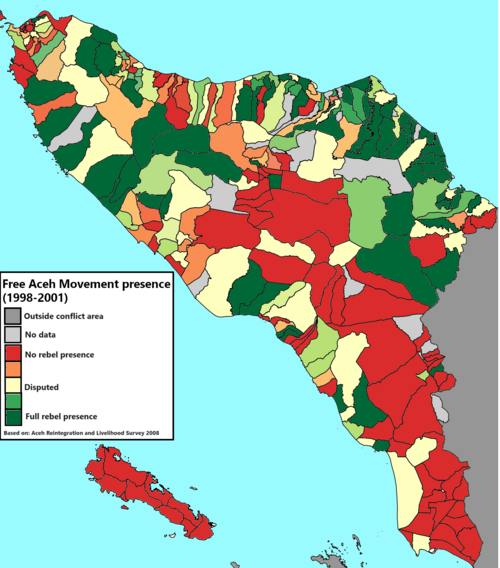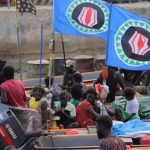Lasting for almost 30 years the Banda Aceh conflict saw the local Acehnese population fight a bitter war for independence or at the very least some form of autonomy.
This carried on alongside the many other conflicts in Indonesia until the 2006 tsunami devastated the region. Said devastation gave both sides the impetus to implement a peace plan. And while peace has largely been kept for 20 years things are far from perfect with some unhappy that changes have gone too far while others feel they have not gone far enough.
So what is the situation in Banda Aceh now? Well it is not just complicated but somewhat different to the rest of Indonesia.
The Banda Aceh Conflict
The roots of the Banda Aceh conflict can be traced back to 1976 when the Free Aceh Movement or GAM declared Aceh independent from Indonesia. This was not the first time Aceh had resisted rule from Java with the region having a long and proud history of being fiercely independent. When the Dutch colonised Indonesia Aceh was the last area to fall. After independence was achieved from the Dutch in 1949 Aceh was lumped into the new Republic of Indonesia rather than being granted autonomy as many felt it deserved.
The core of the conflict revolved around three main grievances. The first was the exploitation of natural resources with Aceh being rich in oil and gas and Jakarta taking most of the profits. The second was political domination from Java with locals feeling marginalised in their own land. The third was the religious and cultural divide with Acehnese people being devoutly Muslim and often feeling more connected to the wider Islamic world than to secular Indonesia.
Things escalated brutally during the DOM period from 1989 to 1998 when Aceh was declared a military operations zone. Thousands were killed disappeared or tortured with entire villages accused of harbouring rebels. Despite a brief lull in the early 2000s the conflict continued until the 2004 tsunami killed over 150000 people in Aceh. In the aftermath both sides realised that enough was enough and with international pressure a peace deal was signed in Helsinki in 2005.

The Current Political System
As part of the 2005 peace agreement Aceh was granted special autonomy within Indonesia. This autonomy allowed for the implementation of Sharia law within Aceh something which GAM and conservative Islamic groups had long demanded. It also allowed for the creation of local political parties in Aceh something not permitted elsewhere in Indonesia. This meant that former rebels could run for office and shape the region politically rather than militarily.
Today the region is governed by a provincial government with its own local laws court systems and even police forces that enforce Sharia. These laws apply mostly to Muslims and cover areas such as alcohol gambling dress codes and relations between men and women. Public floggings are still carried out for violations and are regularly filmed and circulated online.
At the same time Aceh remains part of Indonesia and subject to national law meaning there is often a disconnect between what is permitted nationally and what is enforced locally. The system is seen by some as a successful compromise that has maintained peace while allowing cultural and religious identity to flourish. Others see it as a broken structure that isolates Aceh from the rest of the country and imposes rule without accountability.

Why Are Some People Unhappy?
Despite peace holding for nearly two decades many Acehnese feel let down by the current system. On one side of the political spectrum you have hardline Islamists who feel that Sharia law has not gone far enough. They argue that enforcement is inconsistent and that too many people are still able to flout the rules with impunity. These groups tend to favour deeper religious governance and stricter laws often drawing inspiration from the Gulf and beyond.
On the other side you have secular liberals and human rights activists who argue that the system is oppressive especially towards women minorities and the poor. For them the implementation of Sharia has turned Aceh into a semi-theocracy where freedoms are curtailed and dissent is crushed. There have also been accusations that the Sharia police target the weak while turning a blind eye to corruption and abuse by the elite.
Politically former GAM members have splintered into multiple parties some of which have become just as corrupt and disconnected as the politicians they once fought against. Many locals complain that jobs remain scarce infrastructure is underdeveloped and money from Jakarta still disappears before reaching the people. There is also a growing sense that the autonomy deal has failed to deliver true self rule with Jakarta continuing to exert control through economic and legal mechanisms.
What unites both ends of the political divide is the belief that the current system is neither truly Islamic nor truly independent but something in between that serves the elite and punishes the poor.

Conclusion of the Banda Aceh Conflict
While peace has been achieved the conflict has never truly ended particularly in the background of what is perceived as Javanese imperialism. There are though positives which move far beyond people not getting killed.
Chief among them is that the people of West Papua and beyond see this as a potential mirror for a system they would like. It has also conversely helped more liberal elements within Indonesia with the perceived failure of Sharia marking a warning for the rest of the Indonesian people.
Aceh today remains a land of contradiction and complexity. For the traveller it is a fascinating window into a different side of Indonesia. For its people the struggle for identity dignity and justice continues behind a fragile veil of peace.
Click to check our Indonesia Tours.





